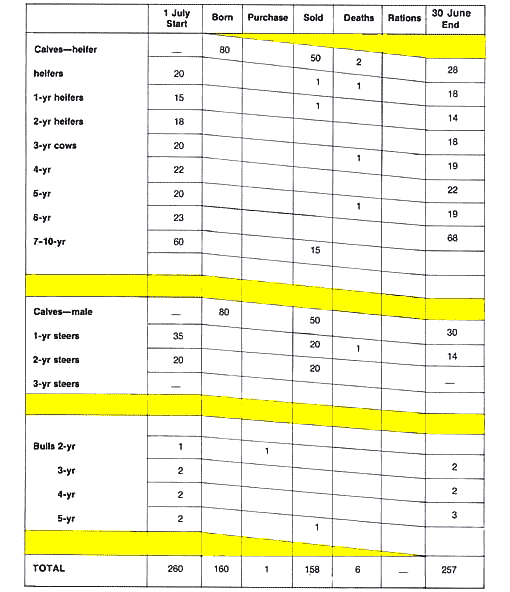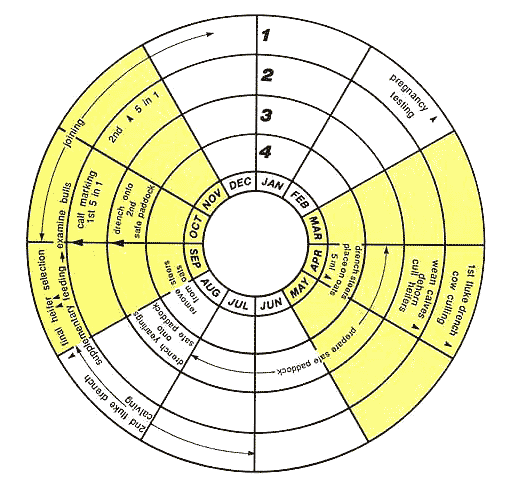
Record keeping and management planning
Introduction
Two Agfacts have been produced to cover the topic of ‘records for beef producers’:
- Agfact A2.8.1 Record keeping and management planning
- Agfact A2.8.2 Record keeping for herd improvement
The recording systems outlined present a package of practical records for beef producers. They can be changed to suit your particular needs. The number of records maintained and the detail recorded will vary according to individual needs and how the information is to be used. Each record should have a specific objective and be used for that purpose.
This Agfact, the first of the two-part series, looks at property and whole-herd record-keeping options, and management planning. While the emphasis is on commercial herd records, the options apply to seedstock producers as well.
Why keep records?
Record keeping is a key component of managing an efficient farm business. Records are needed not only for legal, financial and taxation purposes but also for maintaining a permanent record of the farm business, analysing the business, monitoring day-to-day activities, and future planning.
Quality assurance programs, such as Livestock Production Assurance (LPA), CATTLECARE, and the Meat Standards Australia (MSA) grading scheme, require records as part of their assurance elements. The records suggested in this Agfact are all suitable for meeting the requirements of LPA, CATTLECARE and the MSA grading scheme.
Keep your record system simple
Keep your record system simple and concise. It is worth recording only the information you will use. This applies to both physical and financial aspects of your farm business. Records should be transferred to a summary sheet for easy interpretation and should ideally be linked to your financial recording system.
Computers
Computers are rapidly becoming the preferred and most efficient form of record keeping. Software is continually being developed, enabling relevant information to be entered quickly and easily. Such programs not only store information but can be used to analyse data and generate simple or detailed production and financial summaries. Various programs are available according to the level of record keeping required.
Property records
Farm diary
Almost every producer maintains a farm diary. It is used to record major activities carried out on the property. Individual requirements will determine the entries made and the detail recorded.
Specially designed rural diaries allow you to keep simple, specific records under prepared headings. Most of these diaries contain livestock recording sections, allowing you to keep all your stock information in one book.
Most farmers also have a pocket notebook to record day-to-day activities. These notes should be regularly transferred to the farm diary or computer.
Farm map
A farm map, drawn to scale, showing features such as paddock fencelines, dams, yards, windmills, underground pipe locations, access roads and tracks etc. is a tremendous aid. Drawn up and framed on a backing board, it can be covered in glass or clear plastic, or be attached to a pinboard. Use felt-tipped pens to record details on glass-covered or clear-plastic-covered maps. Use drawing pins for pinboard-mounted maps. Alternatively, computer programs are available to produce farm maps.
Paddock book
A paddock book is the master record for paddock history information. The main purpose of keeping a paddock book is to observe long-term trends. Details to record include:
- fertiliser, herbicide and insecticide treatments
- cultivation details
- pasture improvement details
- stocking details
Additional information may include pasture quality and quantity details and returns from each paddock.
Livestock records
Livestock book
The livestock book is kept as a permanent record, filled in each month from entries in the farm diary or from the paddock book. It is a summary of the movements and management of your livestock throughout the year.
Recommended layout of a livestock book
A livestock book can be set up as shown in Table 1:
- Columns to describe your herd:
- Calf column — records calves born
- Weaner column — records weaners carried
- 1-year column — records yearling cattle carried
- 2-year column — records cattle 2 years of age
Both male (M) and female (F) numbers usually need to be known, e.g. if you turn off 2-year-old steers or retain heifers. Add/delete columns to suit your operation. If you wish to record the breeders by age, add columns to suit the age breakdown you require.
- Use brackets ( ) or a red pen to show ‘Sales’, ‘Deaths’, ‘Missing’ and ‘Rations’
- When you make an entry to the right of the ‘Total’ column, you must also make/change an entry to the left of that column
- The ‘Total’ column records the running total of stock on hand
- The opening entries of your stock schedule can come from your stock-on-hand numbers, shown on your livestock trading account in your end-of-year accounts
- This system can show you, at any time of the year, livestock numbers on hand
- Local Land Services returns can be taken directly from this livestock book
- The only foreseen drawback with this system is transferring stock to new age groups. However, a livestock summary can achieve this and show transfers
| Calves | Weaners | 1 yr | 2 yr | 3 yr+ cows | Bulls | Total | Births | Purc. | Sales | Deaths | Missing | Rations | Comment on activities | ||||
|---|---|---|---|---|---|---|---|---|---|---|---|---|---|---|---|---|---|
| M | F | M | F | M | F | M | F | ||||||||||
| 20 | 35 | 15 | 20 | 18 | 145 | 7 | 260 | On hand 1 July | |||||||||
| 80 | 80 | 420 | 160 | Calves dropped Aug./Sept./Oct. | |||||||||||||
| (2) | 418 | (2) | Calf deaths Aug. | ||||||||||||||
| (20) | 398 | (20) | 2-yr-old steers sold Sept. @ $300 each | ||||||||||||||
Adapted from Table 1.1, page 12, Practical Farm Business Management , by VJ Pollard and WJ Obst.
Livestock summary
A livestock summary can be used to summarise stock numbers and account for all increases due to births and purchases, and all decreases due to sales, deaths and rations. The source of information is the livestock book.
Recommended layout of a livestock summary
An example of a livestock summary is shown below. Points to note in using the livestock summary are as follows:
- This format automatically transfers age groups of livestock to the next age group
- To read the format, place a ruler across the summary in a straight line. The starting numbers as at 1 July, and the closing numbers as at 30 June next, can then be read
- Within the lines sloping left to right, record stock numbers for each heading as applicable
Table 2. Example of a livestock summary For example, 7-10yr cows On hand at start 1 July 60 During year sold 15 − = 45 At the end of the year 30 June, 6-yr cows move into the 7–10-yr group 23 + Number of 7–10-yr cows at 30 June = 68 - This summary can be used by your accountant to make up your livestock trading account and end-of-year financial accounts. You will need to provide the values of sale income and purchases.
- Use stock numbers on hand at 1 July as the starting point for the summary.
- It is not necessary to break up the age structure of your breeding herd as the example shows. If you do break up your breeding herd into age groups, you need to record the ages of cows sold or found dead to balance age numbers.
- It could be to your advantage to know the age structure of your breeding herd and fattening stock. The information can be directly applied to purchase decisions and cash flow budgets.
Livestock summary

Herd build-up
The format shown in the livestock summary above can be used to plan any herd build-up you may be contemplating. Simply draw up the format shown for each year and, using calving percentages and average deaths, sales etc., map out your build-up each year until you reach your target.
The summary you draw up can be used to assess purchase options that may exist to reach your herd build-up in less time. It can also be used to develop a cash flow projection when you are seeking finance.
Talk over your records with your fellow producers, accountant, and NSW Department of Primary Industries (NSW DPI) advisory officers before you settle on a system. Do not be afraid to alter the system if you are not satisfied with it.
Herd management planning
A herd management planner is a checklist of all the herd management operations to be undertaken during the year, listed against specific months. It serves as a planning record at decision-making time and as a reminder of work to be done in the coming weeks.
On beef/sheep and beef/farming properties a herd management planner, adapted for all the enterprises, can identify high-labour-requirement periods and where enterprise operations are competing for your time.
Example formats
The two most commonly used formats are a straight table-type format and a circular segmented format. Examples of both are illustrated and explained below. (The coloured backgrounds in both formats highlight the same periods: March-April-May, and September-October-November.)
Table format
The table-type format shown is for a property where cows are calving in both spring and autumn. You can easily draw up your own on a large sheet of paper or on cardboard.
| Month | Spring herd | Autumn herd |
|---|---|---|
| January |
Mating ends mid-month. Sell steers. Second vaccination for calves. |
Vaccinate cows for clostridial diseases and leptospirosis before calving. Sell steers. |
| February |
Mark calves. Sell steers. |
Calving starts. Sell steers. |
| March |
Pregnancy test cows. Cull empties. | Calving. |
| April |
Calving ends. Test bulls for mating. Select heifers and start early mating. | |
| May |
Grade and wean calves. Lice spray. |
Mating starts. Lice spray. Mate. |
| June |
Cows run in pre-calving paddocks. Second lice spray. | Second lice spray. |
| July |
Vaccinate cows for clostridial diseases and leptospirosis before calving. Annual vaccination of all non-breeding stock. |
Mating ends. Mark calves. |
| August | Calving starts. | Second vaccination for calves. |
| September | Calving. |
Pregnancy test cows. Cull empties. |
| October |
Calving ends. Select and test bulls for mating. Select heifers and start early mating. | |
| November |
Mating starts. Sell steers. |
Grade and wean calves. Sell steers. |
| December |
Mate. Sell steers. First calf vaccination for clostridial diseases and leptospirosis. |
Cows run in pre-calving paddocks. Sell steers. |

Circular format
In the example of the circular format given below, the concentric circles have been used to plot management programs for specific groups of cattle:
- breeding herd
- calves
- yearlings
- fattening steers
The segments are used to divide the year into months to plot management operations for each month. As you change any management operation for your herd, or the timing of any operation, revise your planner to keep it up to date.
The examples of the table format and the circular format given above do not show specific dates for any management operations. These can be added to your planner in the following way:
- For the table format — provide a separate line for each week in a month. This will provide the structure for a weekly time restraint.
- For the circular format — subdivide the monthly segments so that there is a segment for each week of the month. Triangle arrowheads can be used to pinpoint specific dates.
Further information
See also Agfact A2.8.2 Record keeping for herd improvement.
Acknowledgment
This Agfact is based on earlier print editions of Agfact A2.8.1 Options for record keeping and Agfact A2.8.4 Beef herd management planner, written by Ian Blackwood, District Livestock Officer (Beef Cattle and Horses), NSW Agriculture.

